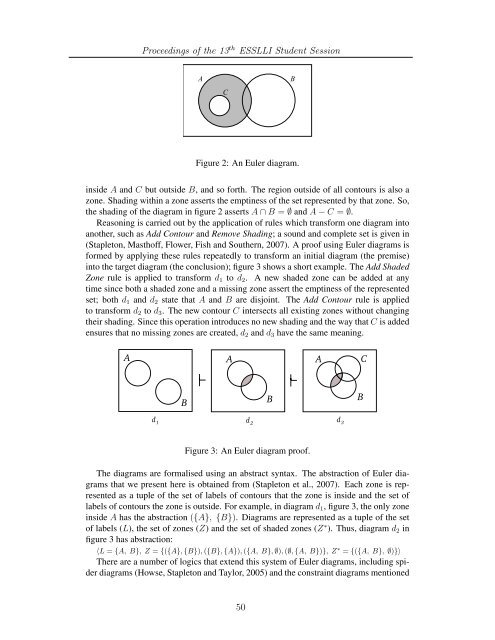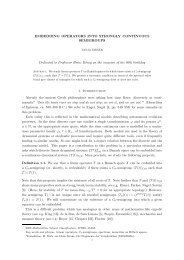Proceedings of the 13 ESSLLI Student Session - Multiple Choices ...
Proceedings of the 13 ESSLLI Student Session - Multiple Choices ...
Proceedings of the 13 ESSLLI Student Session - Multiple Choices ...
Create successful ePaper yourself
Turn your PDF publications into a flip-book with our unique Google optimized e-Paper software.
<strong>Proceedings</strong> <strong>of</strong> <strong>the</strong> <strong>13</strong> th <strong>ESSLLI</strong> <strong>Student</strong> <strong>Session</strong><br />
Figure 2: An Euler diagram.<br />
inside A and C but outside B, and so forth. The region outside <strong>of</strong> all contours is also a<br />
zone. Shading within a zone asserts <strong>the</strong> emptiness <strong>of</strong> <strong>the</strong> set represented by that zone. So,<br />
<strong>the</strong> shading <strong>of</strong> <strong>the</strong> diagram in figure 2 asserts A ∩ B = ∅ and A − C = ∅.<br />
Reasoning is carried out by <strong>the</strong> application <strong>of</strong> rules which transform one diagram into<br />
ano<strong>the</strong>r, such as Add Contour and Remove Shading; a sound and complete set is given in<br />
(Stapleton, Masth<strong>of</strong>f, Flower, Fish and Sou<strong>the</strong>rn, 2007). A pro<strong>of</strong> using Euler diagrams is<br />
formed by applying <strong>the</strong>se rules repeatedly to transform an initial diagram (<strong>the</strong> premise)<br />
into <strong>the</strong> target diagram (<strong>the</strong> conclusion); figure 3 shows a short example. The Add Shaded<br />
Zone rule is applied to transform d1 to d2. A new shaded zone can be added at any<br />
time since both a shaded zone and a missing zone assert <strong>the</strong> emptiness <strong>of</strong> <strong>the</strong> represented<br />
set; both d1 and d2 state that A and B are disjoint. The Add Contour rule is applied<br />
to transform d2 to d3. The new contour C intersects all existing zones without changing<br />
<strong>the</strong>ir shading. Since this operation introduces no new shading and <strong>the</strong> way that C is added<br />
ensures that no missing zones are created, d2 and d3 have <strong>the</strong> same meaning.<br />
Figure 3: An Euler diagram pro<strong>of</strong>.<br />
The diagrams are formalised using an abstract syntax. The abstraction <strong>of</strong> Euler diagrams<br />
that we present here is obtained from (Stapleton et al., 2007). Each zone is represented<br />
as a tuple <strong>of</strong> <strong>the</strong> set <strong>of</strong> labels <strong>of</strong> contours that <strong>the</strong> zone is inside and <strong>the</strong> set <strong>of</strong><br />
labels <strong>of</strong> contours <strong>the</strong> zone is outside. For example, in diagram d1, figure 3, <strong>the</strong> only zone<br />
inside A has <strong>the</strong> abstraction ({A}, {B}). Diagrams are represented as a tuple <strong>of</strong> <strong>the</strong> set<br />
<strong>of</strong> labels (L), <strong>the</strong> set <strong>of</strong> zones (Z) and <strong>the</strong> set <strong>of</strong> shaded zones (Z ∗ ). Thus, diagram d2 in<br />
figure 3 has abstraction:<br />
〈L = {A, B}, Z = {({A}, {B}), ({B}, {A}), ({A, B}, ∅), (∅, {A, B})}, Z ∗ = {({A, B}, ∅)}〉<br />
There are a number <strong>of</strong> logics that extend this system <strong>of</strong> Euler diagrams, including spider<br />
diagrams (Howse, Stapleton and Taylor, 2005) and <strong>the</strong> constraint diagrams mentioned<br />
50

















